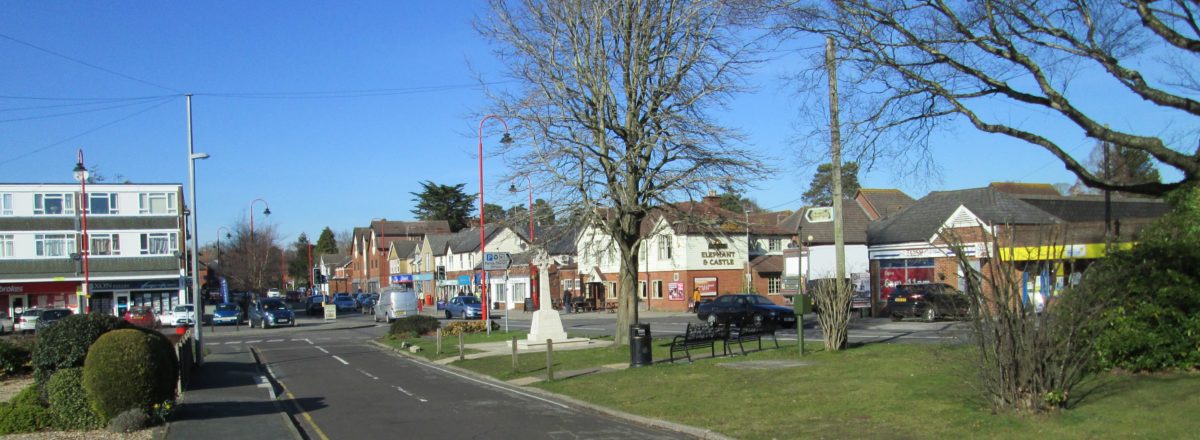Much of the information built into the text below is based upon analysis of census returns, parish records and the like; I have no access, even if it was available, to contemporary notes, letters etc., relating to the people involved. I’m as sure as I can be, after spending nearly two years researching, that the ‘story’ is as accurate as can be, but allow for some errors: if you know differently, particularly if you are related to the families described, I would be delighted if you would make contact.
The impact of the railway upon West Moors was small until the hamlet became, in 1866, the point where the railway line from Salisbury (The Salisbury & Dorset Junction Railway) joined what was then the main line running across SW Hampshire and southern Dorset on the way to Poole, Dorchester & Weymouth, the latter the main port serving the Channel Islands traffic at this time.
Before this, resident staff were only required at the crossing lodge but a railway junction requires additional personnel to operate the points & associated signals. Control of the ‘switch’ was rudimentary. An elevated platform was provided for the ‘points-man’ or ‘policeman’ to see the approach of the train – then he had to climb down to the ground and physically switch the blades of each point as required. In time, this developed into the familiar enclosed signal box operation once common on our railways.
The staff in charge of these operations had to be trustworthy and intelligent. In rural areas, young men from humble, ‘yeomen’ stock, who would otherwise have had little option other than to follow their fathers & grandfathers in finding work on the land, or allied callings, sought employment in this role.
Two such were Thomas Larcombe & John Woolford; together they served the local railway here in West Moors through six decades, from the 1860s to the 1910s.
Thomas Larcombe was born in 1840 in the tiny village of Hewish, Somerset, which is about one-and-a-half miles southwest of Crewkerne. Hewish is a small community today – in the 1840s as for much of its life, it was even tinier, based around a church, a cluster of farms etc.
In 1860, what would become the London & South Western Railway’s West of England main line (between Salisbury & Exeter) opened, passing just northwest of the village. Thomas, now aged 20, would have been very aware of all the activity as the railway line runs very close-by. Surveying and construction would have taken place from 1858, when he was in his late-teens and for a young man wanting to move on to better things, the activity must have been exciting. We don’t have any record of how he came to gain employment on the railway: in 1851, when he is listed as 10 years old, he is an ‘Agricultural Labourer’ (as was his father) and given that his education must have been limited, it would be sensible to assume that Thomas’s life would revolve around work on the land. But he must have gained employment on the railway – perhaps as a porter at Crewkerne. Wherever he was, he would have heard of the opportunities elsewhere on the ‘South Western’.
Aged in his early twenties Thomas came to West Moors, initially as a railway gatekeeper, then becoming one of the ‘pointsmen’ at the new Junction when it opened in 1866. Three years earlier (1863) in West Parley church, he had married a girl who came from Powerstock in west Dorset, Mary Woolridge who bore him 3 children: eldest son Samuel James, born in 1866, daughter Timbey (or Timbley) born in 1868 and another daughter, Adelaide Mary in 1870.
[ note: the first ‘Mary’ enters this tale – see section re: Mary Lane below]
Sadly, in 1871, aged just 27, Thomas’s wife died, leaving him with three young children to look after. It seems from tracing the census entries that Mary & the children went back to Powerstock (her childhood home) for a while, though her death is registered in Wimborne; she probably died here in West Moors, as Wimborne is the registration district covering the village at the time.
Given his wife’s obvious fragile health, Thomas would not be able to devote the time to the care she would need in her final months of life – and of course there was none of the ‘social support’ that we have today. In 1870 Thomas was listed on a baptismal record (for Adelaide, known as Ada) as a ‘labourer’. We can guess that given that the job of pointsman / signalman was very demanding that he had to give up that way of life. It must have been a sad time for so many reasons. After Mary’s death, their children were taken in by other members of the family, leaving Thomas alone. Samuel would go on to work on the railway himself, being found in the 1901 census in Isleworth, Middlesex in the post of Station Master. He died in 1930. Timbley (or Timbey) went to live with her aunt & uncle in Westminster, where she died, aged 7, in 1875. Ada (or Adelaide) Larcombe went to live with her maternal grandmother for a while in west Dorset, but after Thomas’s second marriage (more anon), she had come back to live with his new mother-in-law in West Moors by 1881; however by 1891, then aged 21, she had left the area and was working as a live-in servant in a large household in Kent where she drops out of our story.
Back to Thomas: it is obvious that he was a man not to let life and its problems get him down. By the 1871 census return [April 2nd], his first wife having only recently died, he is living in No.2 Railway Cottages, hard-by the junction (literally – the railway line was only a matter of a few feet away!) with two lodgers – Thomas is back in his former job of railway signalman and his lodgers were a gateman and pointman on the same railway. The listing of a ‘pointman’ suggests that we are in the transitional spell in railway signalling / control, changing from the system whereby the points were physically ‘switched’ by hand and trains individually signalled at the signal post to one where the points and signals are connected by rods / wires to a platform (for the signalman to stand on and view operations). This would then develop to the familiar signalbox with an ‘operating’ or ‘lever’ platform where the signalman would operate the various levers, sitting on top of a ‘frame’ or ‘apparatus’ room where over time, the signal and point motions would be linked to facilitate inter-locking. This prevented the signalman allowing conflicting train movements over the junction.
Not far away from the railway station (and its signalbox and cottages), the Woolfords ran a farm. Inspecting the 1861 & 1871 census returns, I would place this farm as between the Crossing Lodge & the original ‘National’ school, which latter was somewhere in the region of the current Memorial Hall. I suggest (though can’t prove) that the farm was in fact on land where Brook View now stands, just off Riverside Road: there is an adjacent thatched house (mentioned in ‘West Moors for Ferndown’ as an “old thatched farmhouse” in the 1920s) which may be suggestive. In this case, it would have been very close to the Junction. [After-note, written in 2019: it now seems that this farm house was indeed the abode of the Woolfords at this time.]
George and Elizabeth Woolford had come from Sixpenny Handley, in the parish of Wimborne St. Giles in Dorset, not far away in Cranborne Chase. There George was a gamekeeper on a large estate; however, he was obviously not content to work for someone else and had moved to West Moors by the time of the 1861 census and took over a farm close to the railway, totalling some 30-odd acres: they were helped by their children, including Mary Ann (eldest child/daughter) and John, youngest child. [NB: no railway station or large staff at this time.]
Whilst Mary Ann, with other siblings, remained at home and helped run the farm, John joined the railway, marrying Mary Hatchard (a local West Moors girl) and in 1871 at least, he (with his wife) were to be found in Dorchester, he working as a porter. He returns to our story shortly …
[ This is the second ‘Mary’ to enter our story (see section below re: Mary Lane: though not linked to this particular family story, another ‘Mary’ (our third) is living in the Railway Cottages in at least 1871 – Mary Stone, wife to James who is listed as a labourer. And for good measure, they have a young daughter, also called Mary!]
In 1872, Thomas Larcombe, now a widower but with a good, solid job, was 34 years old. Given the proximity between them, he would have been aware of Mary Ann Woolford living with her parents a little way away on the other side of Station Road.
Mary was obviously a hard worker as the Woolfords had increased their acreage from 30 to 50 by the time of the 1871 census return, yet there were only the parents and a couple of children to run the farm. [ And this is the fifth ‘Mary’ in our narrative! ]
How Thomas and Mary got together we don’t know. West Moors was a very small, ‘closed’ community at this time: the total population, widely scattered across the area was around 160, in little more than 30-odd dwellings; the population of the immediate area around the station (from Helliers Farm, later West Moors Farm to the south to the School/PO & General Store in the north) was less than 50, with only three women of marriageable age (at this time). Thomas would almost certainly have had to visit the farm periodically to get such as eggs, milk, the odd chicken etc., given that he was ‘doing for himself’ in the Cottages. Who chased whom I wonder?
Whatever, in 1872, Thomas Larcombe (widower) married Mary Ann Woolford (spinster). Given her age (35), this would have been thought a little ‘advanced’ for child-bearing, but she was obviously a robust lass and she & Thomas produced three children – one of whom, Florence would later become one of the coal merchants in West Moors station yard and also the village’s first sub-postmistress.
As already noted, Mary Ann’s younger brother, John is working down the line as a railway porter for the LSWR in Dorchester, but by accident or design, and I’d put it as the latter given the family links, by 1876 John had joined brother-in-law Thomas in the West Moors Junction signal-box. And of course John and Thomas were ideally placed to exchange news – being on the same line, and with the telegraph to exchange messages box-to-box. John and Mary came back to West Moors and settled into life in another of the Railway Cottages (or Railway Terrace as some census returns have it), and given the concentration of ‘Marys’, it perhaps suggests that the name “Mary Lane” dates from this time (but see note later): Thomas’s first and second wives having lived in Railway Terrace, with Mary Woolford joining her sister-in-law, Mary Ann Larcombe.
Between them, Thomas and John provided service to the railway, and thus the local community, from the 1860s right through to the 1910s. Thomas retired around 1906 (when he was 65) and John would achieve that age in 1912. I haven’t got an explicit listing of retirement dates, but these years look plausible, and match entries in the census returns of 1901 and 1911 and other records. It means that these two gentlemen covered six decades in their joint-working lives at the local railway station.
This ‘family tree’ (below) attempts to show the links between these two signalmen.
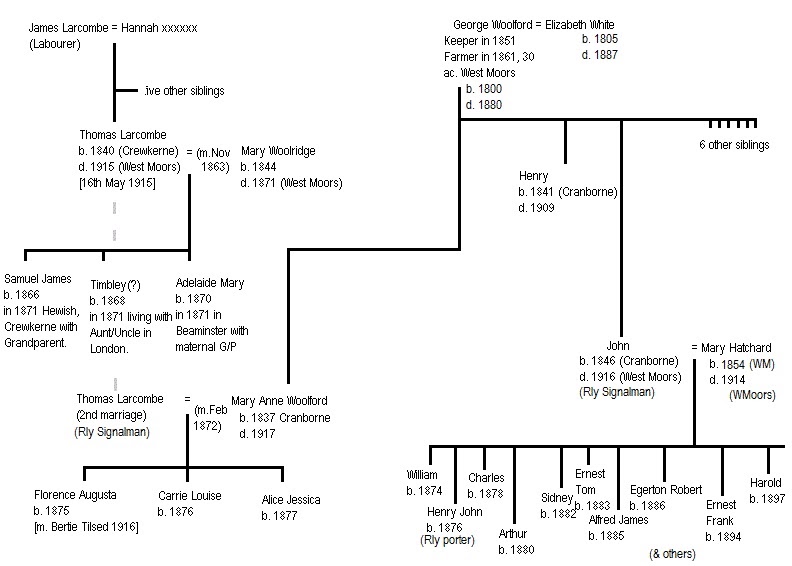
After their faithful service both to the railway and the village, they died within a year of each other; Thomas in May 1915, aged 74 and John in November of the following year, aged 70. As in their long working lives they ‘keep watch’ together, buried just a few yards apart in St. Mary’s churchyard (which is another Mary in our story!) along with their wives and other members of John’s family.

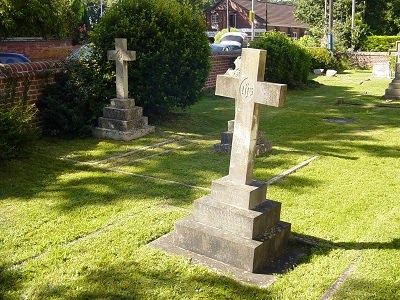
Inscriptions on the two gravestones in the lower image: John & Mary Woolford‘s grave is near the wall (in front of the bush) and Thomas & Mary Larcombe‘s is in the foreground. The other (partially hidden) grave is that of John Woolford’s & Mary Larcombe’s brother, Henry, who died in 1909.
[ Note that John & Mary Woolford’s inscriptions are brief for whatever reason. ]
In Loving Memory of Mary, beloved wife of John Woolford
May 5th 1914
Also of John, her beloved husband November 15th 1916
In Loving Memory of Thomas Larcombe
who peacefully passed away on 16th May 1915, aged 74 years
Rest in the Lord
Also of Mary Anne wife of the above who fell asleep in Jesus 18th June 1917 aged 81 years
For ever with the Lord
The image below is of the second signal-box at West Moors, on the Station Road end of the ‘up’ platform. Both of our subjects would have worked in this structure, which began its working life in 1904, in December. Prior to that date, the signal-box was adjacent to the junction – for location relative to current street layout see the diagram below this one . . . .
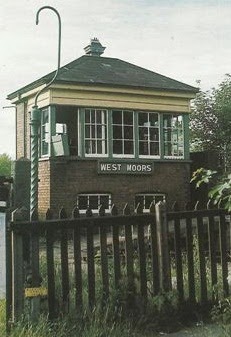
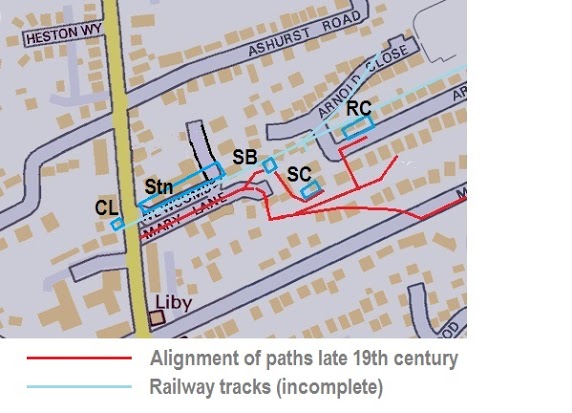
Key to map: CL = Crossing Lodge (extant though modified); RC = Railway Cottages (demolished in the 1960s); SB = Signal Box (the first version, installed in the latter third of the nineteenth century); SC = Signalman’s Cottage; Stn = Station house (the later/1904 signalbox was on the Station Road end of the up platform); Liby = modern Library (for helping with locations). The paths shown (in red) would have been very basic – in the 1920s & 1930s, they were still described as ‘cinder tracks’.
Note that the modern ‘Mary Lane’ is taken to run right through from Station Road to Arnold Road; in ‘railway days’, long before the modern bungalows were built, the lane / track would have diverged where the ‘kink’ is on the map, so strictly speaking Mary Lane is shorter than we generally regard it today.
MARY LANE:
IMPORTANT!
(Written in spring 2016)
. . . The text below relating to the naming of Mary Lane is completely wrong! I’ve left it in to show how one can be led astray when researching these things: I now (May 2016) have found that the name ‘Mary’ was given to the lane (after it had been made up / improved by the developer) in honour of a relative of that developer! Some of the information contained in the following is still relevant though . . . .
At various points in the narrative above, and indeed in the main section of this history (elsewhere), the name ‘Mary‘ crops up. It was of course (and still is, in a variety of forms) a common name to be given girls, especially in rural communities and West Moors is no different in the nineteenth & early twentieth centuries
Up to the 1960s ‘explosion’ of development the naming of streets in the village is reasonably self-evident. Most have ‘bucolic’ associations, and specifically allusions to tree types, woods, moorland, heathland etc. But ‘Mary Lane’ stands out from the rest …..
Maps I have access to before this time (that have street names printed) do not show a name against this track – indeed this is exactly what it is shown as – a track. We know, from ‘West Moors for Ferndown‘ (Deryck Wiseman / Wise Publishing) that at least in the 1920s and 1930s, this was a ” cinder track ” so unlikely to have been given a formal name by the local authority. Its purpose was to allow passage to and from cottages for railway families, without using the path to the end of the ‘down’ platform or crossing the railway lines.
As noted above, ‘Marys’ abound in the 19th century in association with the Railway Cottages – just a collection (terrace) of small dwellings. Based on the 1871 census, large families were crammed into these; Number 1 (the Tillers) had seven people, Number 2 (Thomas Larcombe & lodgers) had three, Number 3 (the Stones) had seven again, two of whom were ‘Marys’ – mother and young daughter; finally Number 4 was itself sub-divided! Ann Blake is living alone in one part; she is 85 years old, whilst the Flippents (all six of them) are in the other part. In all, at this time at least, no fewer than 23 people live in these four small cottages. ( However a word of caution: I’m not absolutely sure that all four of the cottages were in this terrace – there may have been individual / detached dwellings as well, though hardly spacious! )
Over a period of twenty years, I can trace no fewer than five ‘Marys’ here: Mary Larcombe (née Woolridge), the first wife of Thomas who died (see above), Mary Ann Larcombe (née Woolford), his second wife. Also Mary Stone (wife to James) and their daughter, Mary and finally Mary Woolford (née Hatchard).
They wouldn’t necessarily all be living in the terrace, and certainly not all at the same time; there was a separate signalman’s cottage nearby and one of these families, probably the Woolfords (given the size – see family tree above) would be living there. However, they would all have need to use the cinder track: it’s not stretching credulity to suggest that over time, local people would simply talk of the trackway as that which connected the village to ‘the Marys’.
[ But remember – this text is (apparently) wrong! – Pity! ]
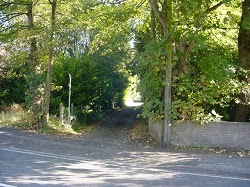
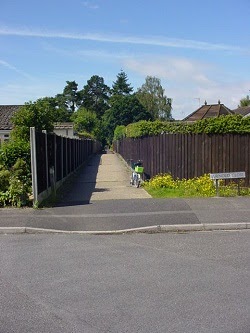
We don’t have any photographs that show the Cottages (or Terrace) except for the one below; this was taken to show the main line (straight ahead) and the junction signals, but you can just make out the cottages (at least some of them) close to the lineside. It fits the description of the times as to how close to the trackbed the dwellings were and their relative position to the junction.
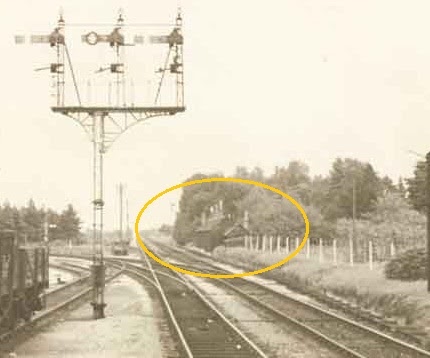
The ‘Railway Cottages’ have long gone – their foundations now form part of the footings for the cluster of bungalows along Arnold Road. I wonder if the residents wake up in the middle of the night to hear the creaking of ghostly wagons with squealing wheels running past their back windows!
Florence Larcombe: first post-mistress in West Moors
As noted above, Florence Larcombe was the eldest of the three daughters of Thomas and Mary Larcombe (née Woolford), his second marriage: although in the 1891 census, when she was 16, she is listed as a ‘domestic help’ (probably in her own home, or one nearby), by 1898 according to Kelly’s directory, she is one of the coal merchants operating out of West Moors goods yard, aged 23. She still has this occupation in the listing for the 1901 census [31st March] – living in the family home in the Railway Cottages (or Railway Terrace); with the rapid growth of West Moors from the mid-1890s, purveying coal to households would have been a profitable trade. By 1903, although she is still listed as a coal merchant and as yet unmarried at the age of 28, she has now assumed the status of sub-postmistress in Moorlands Road. In fact, it looks as if she took on the responsibilities of the post office whilst the family were still living in Railway Terrace (in the very late 1890s), then purchased a property (new-build) in Moorland Road. (See image immediately below for a modern image of No. 16 Moorlands Road – note additional ‘s’)
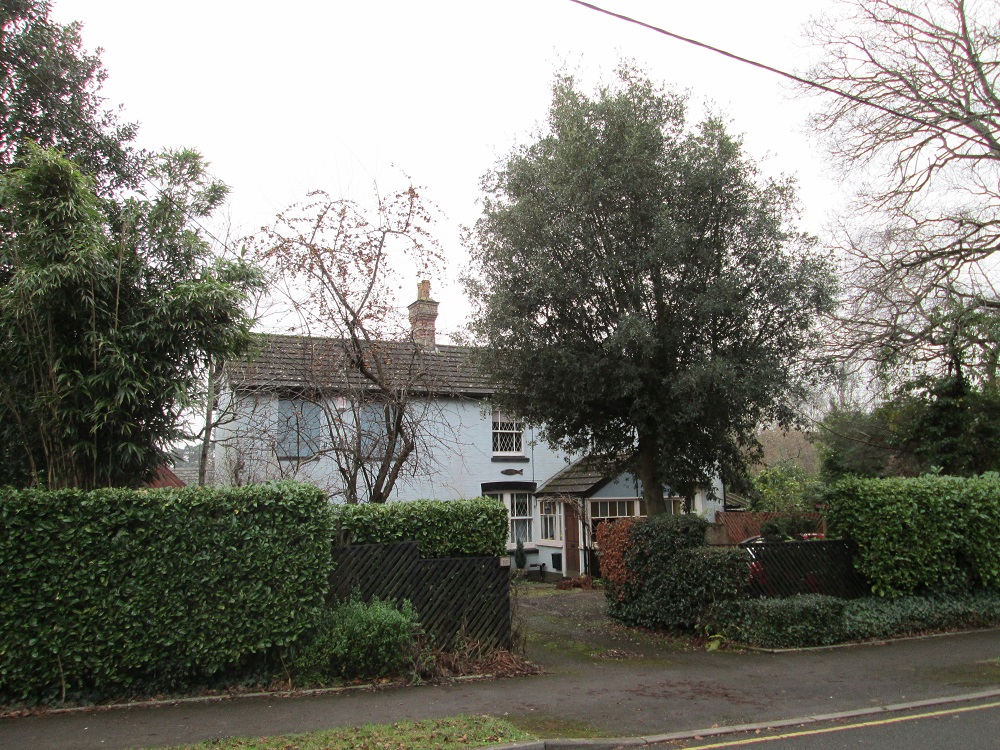
Florence ran the post office & coal business until (at least) 1914, when she married Hedley Bertie Tilsed, a ladies & gentleman’s outfitter/tailor; she was 40, he 6 years younger than she. She is listed as the postmistress (by her married name, Tilsed) in the 1915 business directory. She then at some point thereafter sold the business, as we know that by the 1920s, the post office, with a coal merchant’s attached, is now on Station Road, just down from the Congregational Church (now the United Reformed Church), run by the Nichols (or Nicholls) family. Florence was 40 y.o. on marriage, she probably didn’t produce any children – but I don’t know that for certain; whatever, she was certainly a canny lady! She died in 1952 at a good age of 78, somewhere in Dorset.
